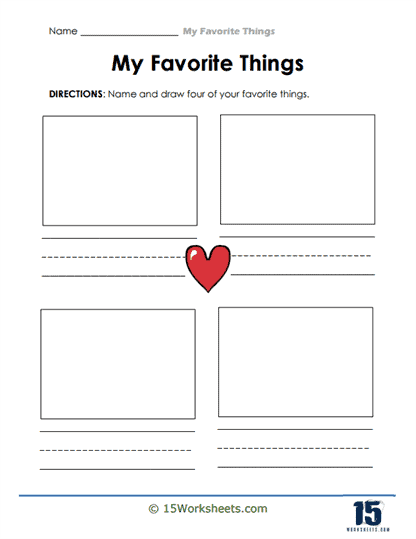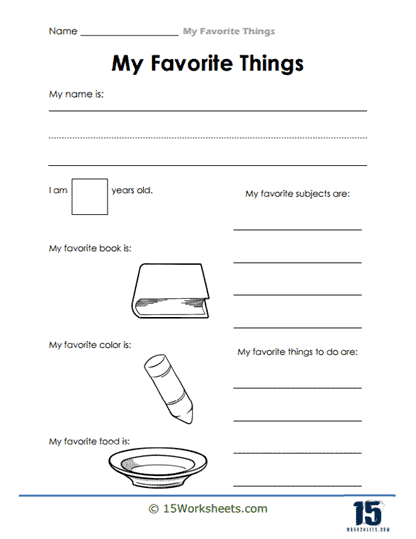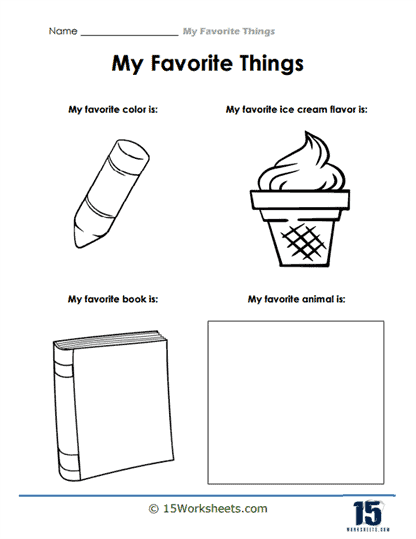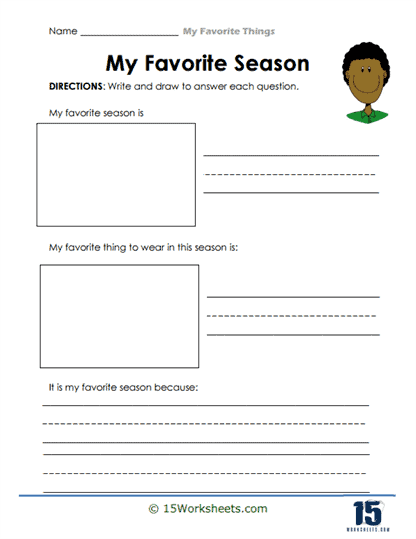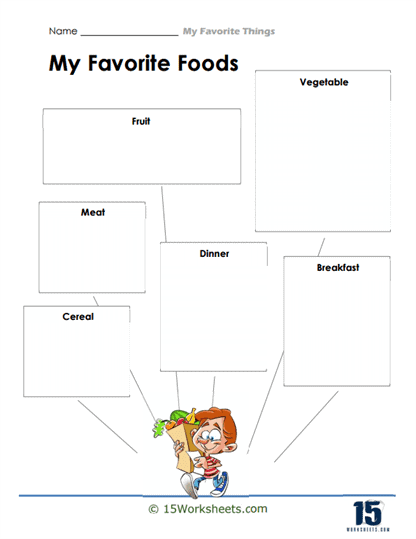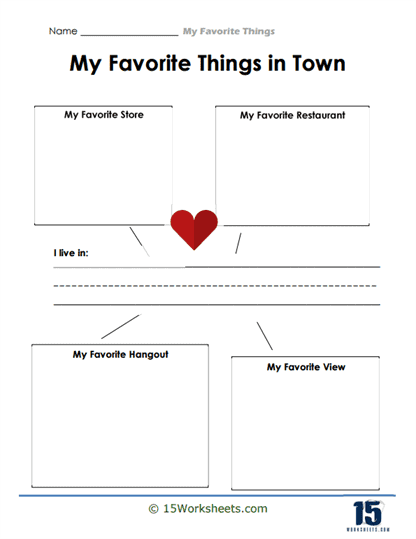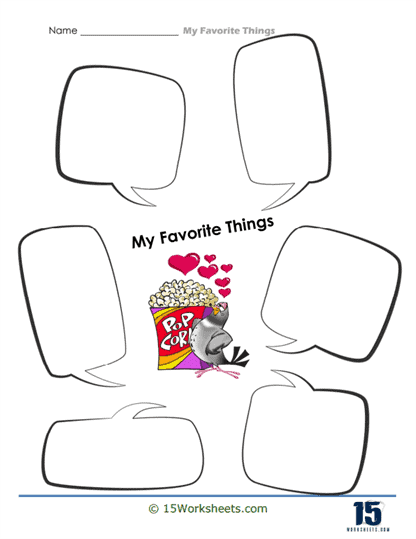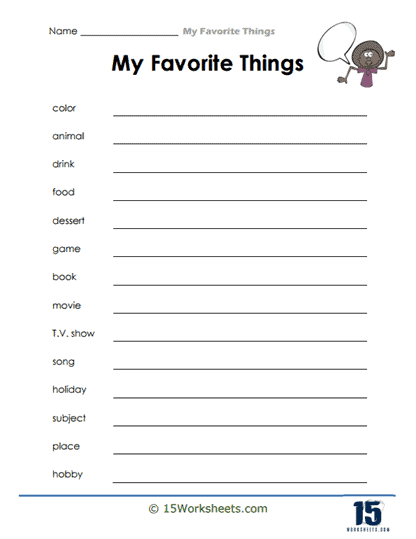My Favorite Things Worksheets
About These 15 Worksheets
This series of worksheets will engage students in exploring and articulating their personal preferences, interests, and passions. These worksheets serve as a platform for self-expression, helping students to identify what they value and enjoy across various aspects of life and culture. Through a variety of exercises, “My Favorite Things Worksheets” facilitate not only personal reflection but also enhance writing, reasoning, and critical thinking skills. Let’s delve into the various types of exercises these worksheets include and how they contribute to a student’s development.
These worksheets can do more than just catalog personal likes; they foster a deep, reflective process that enhances writing, reasoning, and critical thinking skills. Through exercises ranging from list creation to creative storytelling, students are encouraged to explore and articulate their preferences in a structured and meaningful way. This exploration not only aids in developing a stronger sense of self but also improves essential academic skills. Regular engagement with these worksheets can lead to more expressive, thoughtful, and reasoned writing, laying a solid foundation for personal and educational development.
At their core, these worksheets serve as more than just a list-making exercise. They are a means to facilitate self-expression in ways that go beyond simply naming favorite foods, hobbies, or music genres. Through these reflective exercises, students begin to ask themselves important questions: Why do I enjoy this? What is it about this book, this song, or this activity that resonates with me? How do my preferences reflect my broader values and worldview? Such questions are not only useful for personal growth but also play a critical role in developing higher-order thinking skills.
This process of identifying personal preferences, and then analyzing them, helps students in refining their writing skills. Writing becomes not just a task to complete but a medium for self-expression and thought organization. When asked to explain why they enjoy certain things, students are pushed to think critically, to form coherent arguments, and to communicate their reasoning effectively. Whether they are explaining why a particular book has made an impact on them or describing how a piece of music speaks to their emotions, students learn to move beyond the superficial and tap into more complex thoughts. These exercises teach them to write with more purpose, clarity, and depth.
Beyond writing, the worksheets also encourage creativity. Many of the exercises move past simple listing and ask students to engage in more imaginative forms of expression, such as storytelling or scenario building. For example, students might be asked to imagine a day spent doing all their favorite things or to create a fictional world where their favorite activities and objects come to life. Through such creative exercises, students not only learn to articulate their preferences but also use those preferences as a springboard for imaginative thinking. In doing so, they develop the ability to think outside the box and explore new ideas-skills that are valuable in both personal and academic contexts.
Types of Exercises
1. List Creation
One of the foundational exercises is creating lists of favorite things, such as books, foods, places, or activities. This task encourages students to organize their thoughts and preferences in a structured format, promoting clarity and self-awareness.
2. Descriptive Writing
Students are often asked to pick items from their lists and write detailed descriptions about why they are favorites. This exercise demands attention to detail and the use of descriptive language, enhancing their ability to convey emotions and reasoning in writing.
3. Comparative Essays
Some worksheets challenge students to compare two favorite things, explaining their unique qualities and why they hold a special place in their hearts. This fosters analytical thinking and persuasive writing skills, as students must reason and articulate their preferences clearly.
4. Creative Storytelling
Students might be tasked with creating a story or scenario involving some of their favorite things. This exercise taps into creative thinking and narrative skills, encouraging imaginative exploration and storytelling abilities.
5. Thematic Collages
Incorporating art, students can create collages that visually represent their favorite things. This activity allows for a different mode of expression, blending creativity with personal reflection and providing a multidimensional look at their interests.
6. Reflection Questions
Worksheets may include reflective questions that prompt deeper thinking about why certain items are favorites and how they reflect the student’s personality or life experiences. This introspective exercise enhances self-awareness and critical thinking.
7. Interview and Presentation
Some exercises encourage students to interview classmates or family members about their favorite things and present findings. This builds communication skills, empathy, and the ability to synthesize and report information.
Impact on Writing and Reasoning Skills
Engaging with “My Favorite Things Worksheets” significantly bolsters students’ writing and reasoning skills through various means:
1. Enhanced Expressive Writing
By articulating why something is a favorite, students develop their expressive writing capabilities. They learn to convey personal sentiments and preferences in a coherent and engaging manner, refining their voice and perspective in writing.
2. Improved Descriptive Abilities
Writing about favorite things necessitates detailed descriptions that capture the essence of why these items are cherished. This practice hones students’ abilities to use vivid language and sensory details, making their writing more engaging and illustrative.
3. Critical Thinking and Analysis
Comparing favorites or reflecting on why certain things are preferred requires analytical thinking. Students must evaluate their choices, consider various factors, and articulate their reasoning, thereby sharpening their critical thinking skills.
4. Creative and Narrative Skills
Creating stories or scenarios involving favorite things fosters creativity and narrative skill development. Students learn to construct cohesive and imaginative narratives, enhancing their storytelling abilities and creative expression.
5. Organizational and Structuring Skills
Organizing lists and writing structured essays or reports on favorite things teach students how to logically organize their thoughts and present them clearly. These skills are fundamental in all writing and reasoning tasks.
6. Empathy and Perspective-Taking
Interviewing others about their favorites and presenting these findings help students develop empathy and the ability to understand and appreciate diverse perspectives. Recognizing and valuing differences in preferences fosters a more inclusive and empathetic worldview.
7. Reflective Thinking
The reflective aspect of these worksheets encourages students to ponder deeply about their preferences, leading to a better understanding of themselves and their values. Reflective thinking is crucial for personal growth and reasoned decision-making.





